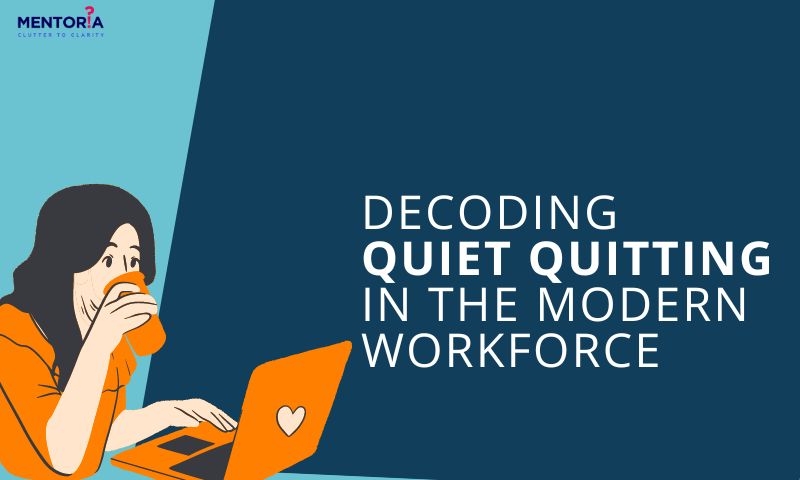Decoding Quiet Quitting In The Modern Workforce

Jump to Section
In the office, there’s a new buzz that’s got everyone talking, and it’s not about the coffee in the break room. It’s all about this phenomenon called “quiet quitting.” Now, you might think that someone is leaving their job, but it’s not quite that simple. Quiet quitting is actually a rebellion against the workaholic culture that has taken over workplaces. People are tired of being expected to do more than what their job requires, and they’ve had enough.
This term, quiet quitting or silent resignation, has gained a lot of attention this year. It has become a viral sensation on platforms like TikTok, and it’s no wonder why. The pandemic and the shift to remote work have changed the way people view their jobs. It has brought to light the issues that exist within the work environment, issues that were not so obvious before COVID-19.
Quiet quitting is a way for employees to take a stand and say, “Enough is enough.” It’s a way for them to reclaim their work-life balance and prioritise their mental health. Instead of burning themselves out by constantly going above and beyond, they are choosing to step back and focus on what truly matters. It’s a movement that is gaining momentum, and it’s forcing employers to reevaluate their expectations and create a healthier work environment for their employees.
In this article, we will explain the term “quiet quitting,” why it arises, delve into related data, discuss how to detect it, and explore ways to resolve it. Let’s dive in
Simplifying The Concept of Quiet Quitting
Quiet quitting is an increasingly common phenomenon in the business world. This is a situation in which an employee decides to abandon motivation for his work without saying anything, without his employer or colleagues realising that something is happening. Unlike explicit resignation, quitting is difficult to detect and can have very negative consequences for the company.
Instead of openly stating that he or she has stopped feeling motivated, interested, and enthusiastic about a particular job, and is considering leaving, the employee may begin to miss work, arrive late, or perform his or her tasks less efficiently. He may complain about his or his colleagues’ work more frequently, or simply show less interest and commitment to the company and the work.
Quiet quitting is a problem for companies because it is often not detected until it is too late. Employees who quit quietly can continue working for weeks, even months, without anyone realising they are considering leaving. And when they finally leave, they can leave a void that is difficult to fill.
In other words, it is a tendency that encourages employees to do only what they are required to do according to their employment contract, not agree to dedicate more hours of work and sacrifice their free time without being paid.
This term can become a controversial issue, since for some managers or human resources personnel it is a threat that their employees apply quiet quitting, however, this has been a position that some workers have assumed in response to exhaustion and excessive demand from the companies where they work.
The Root Causes Behind Quiet Quitting
Possibly, understanding what quiet quitting means may seem a little difficult, for this reason it is necessary to understand what caused this movement in companies. As you can imagine, this situation is not new, this movement has its origins in what we know as “The massive resignation” or The great resignation, which developed in the United States during the second year of the pandemic.
When COVID-19 arrived, companies were forced to change their way of working, since offices were no longer necessary due to the confinement that everyone was forced to comply with. Based on this phenomenon, employees identified that work could be carried out in better conditions, allowing them to have more time for their family or personal matters.
This created an imbalance in the work environment, as many workers decided to resign from their jobs in search of those companies that will offer them better opportunities and one of them was remote work, through established objectives or hours.
Identifying this situation, this sparked the quiet quitting movement, since many companies that had their employees as salaried workers did not set limits on the total number of hours or responsibilities that the employee had to comply with. The workers, not receiving financial remuneration or an opportunity for growth within the company, decided to limit themselves to only complying with what was established in their contract and not giving more hours, ideas or effort, since it was not recognised or paid. Some more causes are as follows:
A Generational Effect
Gen Z is a generation much more concerned about their working conditions and well-being than previous generations. It is no longer acceptable for them to work at any price to earn a living.
The Economic Environment
Quiet Quitting is also influenced by economic conditions. If employees do not feel that they receive a salary commensurate with their duties or that there are other employees who are better rewarded for similar work or with fewer responsibilities, they will seek to do their work with the least possible effort.
Remote Work Realignment
The idea of working to live, rather than living to work, is not at all revolutionary. However, remote work and the pandemic have made it more popular than ever. Quiet Quitting is a consequence of what we have experienced in the last two years, with many changes and fear of work overload.
Compounded By Inadequate Remote Work Support
Working from home distorts the natural bond between employees and the organisation, reducing the role of the company as a place of social construction. Exchanges with managers are scarce, and the employee focuses solely on his own tasks, ignoring his team.
Therefore, employers must create and introduce policies and incentives that sufficiently re-engage their remote employees and avoid Quiet Quitting
The Simple Breakdown Of Quite Quitting Across On A Larger Scale
Below we’ll share some statistics that characterise the phenomenon of quiet quitting, these data were published by the Labor Thermometer of the Online Professional Career Center:
- 34% of the country’s working population is limited to doing only what corresponds to their position, this means that they do not make any additional contribution, since now his priority is to take care of his mental health and his personal life.
- 29% of those surveyed have decided to carry out the quiet quitting, due to low salaries and lack of salary increase, for this is why they make the minimum effort in their current jobs.
- 26% assure that they would carry out quite quitting due to bad leadership and toxic environment.
- 11% stop making efforts due to lack of recognition by the company.
- 43% think that giving your maximum effort does not guarantee a promotion or salary increase, so they are disappointed and simply do not give more than what the company makes financially profitable for them.
Spotting The Silence: Detecting Quiet Quitting In Your Organisation
Early detection of quite quitting is key to preventing employees from leaving the company without notice. Some signs that may indicate that an employee is considering quietly quitting include:
Burnout
Burnout or burnout worker syndrome is already something that is part of the global culture of burnout. In May 2020, the World Health Organisation (WHO) officially recognised burnout as a medical diagnosis, and the impact ranges from effects on mental and physical health to enormous losses in productivity.
Generational Difference
The average workplace is now made up of four different generations, a phenomenon that has never occurred before. While this diversity provides a variety of perspectives, skills, and backgrounds, it also challenges business leaders.
Mental Health
According to the study developed by the Robert Walters Group, 88% of professionals consider mental health policies important when looking for a new position; Therefore, companies with a strong and clear mental health policy are more likely to attract broader pools of talent.
Growth Plan
Performance evaluations are an excellent opportunity to review goals and achievements, learn about the general status of team members and how they are performing their duties. In addition, it allows them to give feedback on projects and plan the next goals and objectives, giving greater clarity about the career plan.
Working Conditions
The percentage of engaged employees under 35 years of age decreased by 6% from 2019 to 2022. Since the pandemic, younger workers have begun to feel worse served and have fewer development opportunities, blaming mainly the manager of this situation
Lack Of Commitment
If an employee seems less interested in their work or the company’s projects, it may be a sign that they are considering leaving. This lack of commitment could be due to unmet expectations or job dissatisfaction. It’s important to talk openly with the employee, find out what’s going on, and create a supportive work environment to keep them engaged and motivated.
Changes In Attitude
If an employee begins to complain more often or display a more negative attitude, it may be a sign that they are unhappy with their job. This dissatisfaction might stem from specific problems, such as feeling undervalued or experiencing burnout. For instance, if an employee consistently expresses frustration about unclear expectations or a lack of recognition for their efforts, it could indicate a deeper issue affecting their engagement.
Frequent Absences
If an employee starts missing work a lot or regularly shows up late without explaining, it could mean they’re thinking about leaving. For example, if someone who used to be on time every day starts being late and gives vague reasons, it might be a sign they’re not as committed. This change in behaviour could also be because they’re not happy with their job – maybe the tasks aren’t challenging, or they don’t see opportunities to grow.
Decreased Productivity
If an employee begins to perform their job less efficiently or loses quality in their role, it may be a sign that they are demotivated. For example, if someone who used to meet deadlines and produce high-quality work starts missing targets and submitting lower-quality outputs, it might be a sign of a motivation issue. If an employee mentions feeling overwhelmed but doesn’t get support or changes, it can lead to a noticeable decrease in productivity.
Reducing The Numbers: Proven Ways To Slow Down Quiet Quitting
Talent Management can be a valuable tool to prevent silent employee resignation in a company. Talent management refers to the set of practices and processes designed to attract, retain and develop talent in an organisation.
In this sense, good talent management can help keep employees motivated and committed to the company. 8 talent management practices that can be effective in preventing quite quitting include:
Creating A Healthy Work Environment
It is important that employees feel comfortable and safe in their workplace. This means fostering a culture of respect, fairness and open communication between employees and leaders. Leader should Monitor excess workload. Most of those who quietly quit complain about doing the work of two or three employees.
Open The Conversation
When employers identify quiet quitters, they should invite them to talk openly about their disappointment and poor performance.
Open and honest conversations with employees are the most effective way to address the problem of quiet quitting. By addressing problems openly, you can eliminate the “silence” of “quiet quitting.” It is important that you clarify that this talk is not intended to punish the employee, but rather to help them feel comfortable enough to be honest.
Listen To Your People
Quiet quitting does not begin in silence. It is not uncommon for employees to express concerns that managers recognise, but do not address or ignore. When team members feel that their bosses are oblivious to their problems, they may take action, or worse, lose faith in their leaders.
Talking to employees and holding regular meetings are great ways to prevent quiet quitting, and active listening is another way to make it more effective.
It is essential that companies periodically survey their people, going beyond productivity and performance KPIs. Listening to workers’ opinions is the first step in improving the organisation’s policy and practices. The best way to obtain the opinion of your employees and align it with your business strategy is to survey them.
Career Development And Succession Planning
Employees and managers can work together to find a better fit within the organisation and, at the same time, rekindle each other’s interests, resulting in a meaningful and rewarding career. Perhaps there is a chance that the tendency toward quiet abandonment will be replaced by re-energised retention, where people feel a renewed sense of pride and passion in their work.
Employees who see a clear path to progress and development within the company are less likely to feel stagnant and unmotivated. A well-structured career development plan can help them set clear and achievable goals, which can motivate them in the long term. Here’s how you can achieve a well structured career development plan
Self-Assessment
- Identify strengths, weaknesses, and interests.
- Reflect on personal values and priorities.
Goal Setting
- Establish specific, measurable career goals.
- Ensure goals are achievable and time-bound.
Skill Development
- Identify and acquire skills crucial for career advancement.
- Pursue training or educational opportunities.
Networking
- Build a professional network through events and online platforms.
- Seek mentorship for guidance and insights.
Action Plan
- Break down goals into actionable steps with a timeline.
- Regularly evaluate progress and adjust the plan as needed.
Regular Performance Appraisals
Regular appraisals allow managers to quickly identify any issues or concerns an employee may have, and they can be addressed before they become a bigger problem. Appraisals can also be an opportunity to provide feedback and recognition to employees, which can improve their job satisfaction.
Maintain Boundaries
Quietly quitting can be the result of a lack of work-life balance and a disregard for work-life boundaries. There may be a constant stream of calls or emails from colleagues or bosses outside of work hours or on vacation, which the employee is expected to answer.
Among the solutions we have:
- Make it clear that it is not mandatory to respond to calls or emails outside of working hours.
- Establish guidelines on what constitutes an emergency outside of work hours and how to mark messages as urgent.
- Allow employees to leave early on another day as a reward for staying late.
- Team members are less likely to overstep those boundaries when you, as a leader, are vocal about employees’ right to private time.
Provide Opportunities For Growth
Job satisfaction and a positive outlook on personal and professional growth play a crucial role in reducing employee turnover. When employees feel content and fulfilled in their work, and have a clear vision of how their career can flourish within their organisation, the likelihood of them leaving diminishes significantly. It is essential for companies to foster an environment that promotes employee happiness and provides ample opportunities for continuous development and advancement. By doing so, they can create a workforce that is motivated, engaged, and committed to the long-term success of the company.
Acknowledge The Work Being Done
Quiet Quitters tend to feel undervalued by the organisation they work for. If work goes unnoticed and is not praised by management, employees believe they could stop working without management noticing or caring about the work, and they are often right. As a result, employees feel as if “no one cares, why try?”
Recognising people for their work is an effective way to combat this mentality. You can show your employees that their work is important to you and the organisation by recognising and rewarding them for their excellent work.
Compensate Your Team Appropriately
A common argument for quitting quietly is “you’re just doing the job you’re paid to do.” Many who quietly quit feel that they are underpaid for the work they do. As a result, they feel that their efforts are unfairly rewarded. This leads employees to reduce their efforts.
If employees are not rewarded for working overtime, they feel that their sacrifices and efforts are not properly valued by their bosses.
The form of compensation can be monetary or non-monetary, such as recognition, bonuses, benefits and flexibility. However, if they are being paid very poorly, arguing for ancillary compensation will be less convincing.
Conduct The Right Surveys
Satisfaction surveys can help detect problems in the company before they become a major obstacle. By asking employees’ opinions about their work and the company as a whole, managers can take steps to improve the culture and working conditions at the company.
Sometimes it is too late to reverse a quiet quitting, resulting in the employee not-so-quietly resigning. Even if a person decides to leave, he should try to improve the work environment in order to retain current employees and protect their passion for the work. A motivation failure can be detected by conducting an exit interview with the employee who is leaving and offering him or her information on how to overcome it.
Rise With Mentoria: Crushing Quiet Quitting’s Silent Battle
In summary, quiet quitting can be a hard issue to identify and can have detrimental effects on the business. Nonetheless, leaders can take action to stop it from occurring in their organisation with the appropriate training. Managers can sustain their staff members’ motivation and commitment to the company by fostering a positive work environment, listening to their concerns, offering opportunities for professional development, praising hard work, and administering satisfaction surveys.
With Mentoria Career Guidance explore 12,000+ career options tailored to your interests, personality, and abilities. Identify a pathway enabling a seamless transition to a new role without starting from scratch. Our counsellors assess your strengths, identify development areas, and craft an action plan. Discover practical ways to make the switch without significant financial impact. Call us to chat with career mentors and begin your journey to a fulfilling and successful future.














